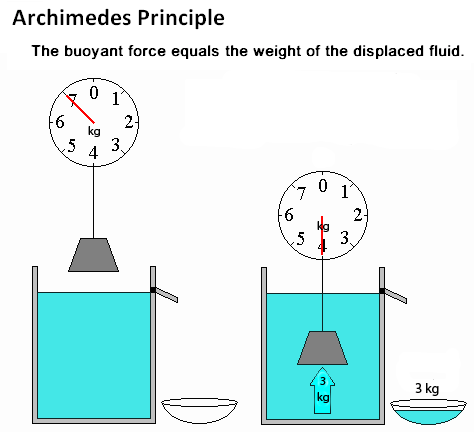

In simple terms, the principle states that the buoyant force on an object is equal to the weight of the fluid displaced by the object, or the density of the fluid multiplied by the submerged volume times the gravitational constant, g. The weight of the object in the fluid is reduced, because of the force acting on it, which is called upthrust. The weight of the displaced fluid is directly proportional to the volume of the displaced fluid (if the surrounding fluid is of uniform density). By extending this reasoning to irregular shapes, we can see that, whatever the shape of the submerged body, the buoyant force is equal to the weight of the fluid displaced. Multiplying the pressure difference by the area of a face gives the net force on the cube - the buoyancy, or the weight of the fluid displaced.

The pressure difference between the bottom and the top face is directly proportional to the height (difference in depth). The fluid will exert a normal force on each face, and therefore only the forces on the top and bottom faces will contribute to buoyancy. In simple words Archimedes principle states that when a body is partially or completely immersed in a fluid, it experiences an apparent loss in weight which is equal to the weight of the fluid displaced by the immersed part of the body.Ĭonsider a cube immersed in a fluid, with its sides parallel to the direction of gravity. If this net force is positive, the object floats if negative, the object sinks and if zero, the object is neutrally buoyant - that is, it remains in place without either rising or sinking.


Thus the net upward force on the object is the difference between the buoyant force and its weight. The upward, or buoyant, force on the object is that stated by Archimedes' principle, above. The downward force on the object is simply its weight. Practically, the Archimedes principle allows the buoyancy of an object partially or wholly immersed in a liquid to be calculated. This result applies for a submerged object of any shape, size, or density.In his treatise on hydrostatics, On Floating Bodies, Archimedes states:Īny object, wholly or partially immersed in a fluid, is buoyed up by a force equal to the weight of the fluid displaced by the object. The buoyant force acting on the steel is the same as the buoyant force acting on a cube of fluid of the same dimensions. The units of the buoyant force and weight are newton ( N ) in SI and "pound force" ( lb f) in British Engineering units. Where B is the buoyant force and W is the weight of the displaced fluid. The buoyant force acts vertically upward through what was the center of gravity of the displaced fluid. The magnitude of the buoyant force always equals the weight of the fluid displaced by the object. The upward force that the fluid exerts on an object submerged in it is called the buoyant force. Evidently, water provides partial support to any object placed in it. As an example of a common experience, recall that it is relatively easy to lift someone if the person is in a swimming pool whereas lifting that same individual on dry land is much harder. Archimedes' principle can be stated as follows:Īny body completely or partially submerged in a fluid is buoyed up by a force equal to the weight of the fluid displaced by the body.Įveryone has experienced Archimedes' principle.


 0 kommentar(er)
0 kommentar(er)
